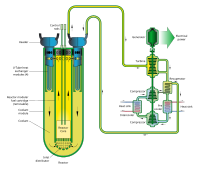
Photo from wikipedia
The supercritical carbon dioxide (SCO2) Brayton cycle has become an ideal power conversion system for sodium-cooled fast reactors (SFR) due to its high efficiency, compactness, and avoidance of sodium-water reaction.… Click to show full abstract
The supercritical carbon dioxide (SCO2) Brayton cycle has become an ideal power conversion system for sodium-cooled fast reactors (SFR) due to its high efficiency, compactness, and avoidance of sodium-water reaction. In this paper, the 1200 MWe large pool SFR (CFR1200) is used as the heat source of the system, and the sodium circuit temperature and the heat load are the operating boundaries of the cycle system. The performance of different SCO2 Brayton cycle systems and changes in key equipment performance are compared. The study indicates that the inter-stage cooling and recompression cycle has the best match with the heat source characteristics of the SFR, and the cycle efficiency is the highest (40.7%). Then, based on the developed system transient analysis program (FR-Sdaso), a pool-type SFR power plant system analysis model based on the inter-stage cooling and recompression cycle is established. In addition, the matching between the inter-stage cooling recompression cycle and the SFR during the load cycle of the power plant is studied. The analysis shows that when the nuclear island adopts the flow-advanced operation strategy and the carbon dioxide flowrate in the SCO2 power conversion system is adjusted with the goal of maintaining the sodium-carbon dioxide heat exchanger sodium side outlet temperature unchanged, the inter-stage cooling recompression cycle can match the operation of the SFR very well.
Journal Title: Frontiers in Energy
Year Published: 2021
Link to full text (if available)
Share on Social Media: Sign Up to like & get
recommendations!